Colorado has four different rattlesnake species. Rattlesnakes are the only snakes in Colorado that are dangerously venomous to humans. They are not the only venomous snakes in the state, though.
Colorado also has four different rear-fanged colubrid snake species. These snakes are venomous, yet they are not considered dangerous to humans.
Finally, four different subspecies of garter snakes live in Colorado. Garter snakes do not have fangs, but their saliva contains a mild neurotoxin that they use to subdue prey.
We will discuss these 12 venomous snakes in the paragraphs below.
Pit Vipers: The Venomous Masters of Infrared Detection
Rattlesnakes, Copperheads, and Cottonmouths are among the most well-known members of the venomous Crotalinae subfamily, also referred to as pit vipers. These snakes are equipped with unique adaptations that make them exceptional hunters.
What Makes Pit Vipers Unique?
- Infrared-Sensing Pits:
A defining feature of pit vipers is the deep facial pit between their nostril and the eye on each side of their head. These specialized infrared-detecting organs allow pit vipers to sense heat emitted by prey. This adaptation enables them to:- Detect body heat from up to 1 meter away.
- Strike prey with pinpoint accuracy, even in complete darkness.
- Triangular Heads and Vertical Pupils:
- Head Shape: Pit vipers are recognized by their distinct triangular-shaped heads, which house their venom glands.
- Eyes: They have vertical elliptical-shaped pupils.
- Venomous Fangs:
Pit vipers have hollow fangs connected to venom glands. These fangs fold back against the roof of their mouth when not in use.
Ecological Importance
Pit vipers play a crucial role in maintaining ecosystem balance by controlling rodent populations. Despite their fearsome reputation, these snakes are vital to the health of many habitats.
Rattlesnakes of Colorado
There are four species of rattlesnakes in the state of Colorado. They are listed below:
- Prairie Rattlesnake (Crotalus viridis)
- Midget-faded Rattlesnake (Crotalus concolor)
- Desert Massasauga Rattlesnake (Sistrurus t. edwardsii)
- Western Massasauga Rattlesnake (Sistrurus tergeminus)
Rattlesnakes are pit vipers. See the description of pit vipers above.
What Colorado’s rattlesnakes have in common with most other rattlesnake species is their rattle.
- Most rattlesnakes have a rattle at their tail’s end, comprised of hollow, loosely interlocked keratinous scales.
- Normally, a rattlesnake adds a new segment to its rattle each time it sheds its skin.
- An agitated rattlesnake rapidly vibrates its tail, causing the segments of its rattle to vibrate together, creating a buzzing or rattling sound.
- Not all rattlesnakes rattle before they strike. Sometimes, they lose their rattles due to injury, and sometimes, they choose not to rattle.
Are Rattlesnakes Dangerous?
Around 200 people in Colorado suffer rattlesnake bites each year. See, The vast majority of these bites are non-life threatening. This is due to most victims having access to prompt medical treatment. However, on rare occasions, rattlesnake bite victims die from their injuries.
The most recent fatal rattlesnake bite in Colorado occurred in 2022. In this case, the victim was a 6-year-old boy who was bitten southeast of Fort Carson, Colorado.
Also another fatal incident happened in 2017. A man was fatally envenomated by a rattlesnake while hiking near Golden, Colorado.
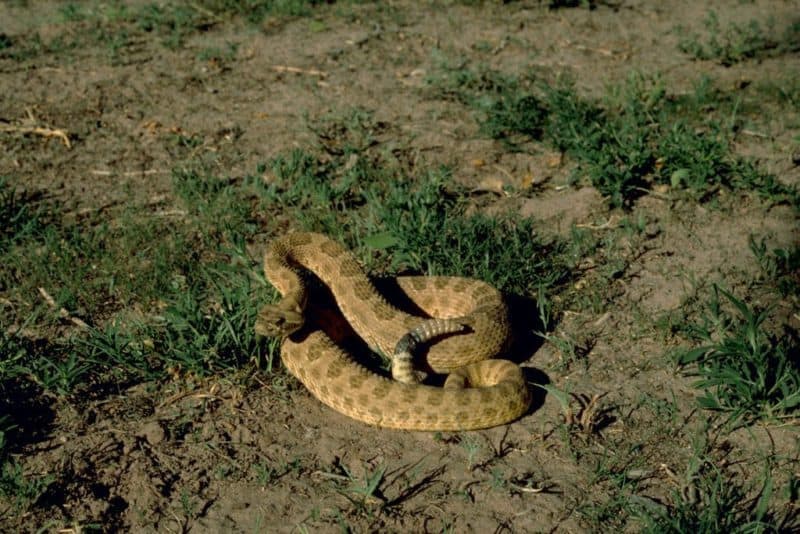
Prairie Rattlesnake (Crotalus viridis)
What Do Prairie Rattlesnakes Look Like?
| Size | *Adults typically measure about 3.3 feet (100 cm) in length. *The longest recorded specimen was just under 5 feet (151.5 cm) long. |
| Coloration | *Their base color varies and can be tan, olive green, or brown. |
| Dorsal Spots | *Brown blotches with darker borders are present on their bodies. |
| Head | *They have a triangular-shaped head with pit sensory organs on either side. *A light stripe runs diagonally from the back of each eye to the jaw. *Another stripe extends diagonally from below the eye to the corner of the mouth |
| Behavior | *Primarily ground-dwelling but occasionally climbs shrubs, bushes, or trees. |
| Conservation Status | Common within their Nebraska range. |
Where Do Prairie Rattlesnakes Live in Colorado?
The Prairie Rattlesnake is found throughout Colorado up to 9,500 feet in elevation. They inhabit open prairies, sagebrush flats, grasslands, piñon-juniper forests, and woodlands. They may reside in prairie dog towns and appropriated prairie dog burrows.
Adult prairie rattlesnakes feed on small mammals such as mice, rats, and prairie dogs. They also feed on lizards, small snakes, eggs, birds, and carrion.
How Dangerous Are Prairie Rattlesnakes?
Prairie rattlesnake venom is a mix of hemotoxins and myotoxins. Furthermore, according to some literature, it also has neurotoxins.
Prairie rattlesnake bites can have serious effects. The venom can cause severe pain. It may also induce shock, making the victim feel weak and disoriented. Swelling, blistering, and inflammation can occur at the bite site. Their venom can also damage red blood cells and impair blood clotting. In severe cases, the bite may result in severe tissue damage. There is also a risk of harm to internal organs.
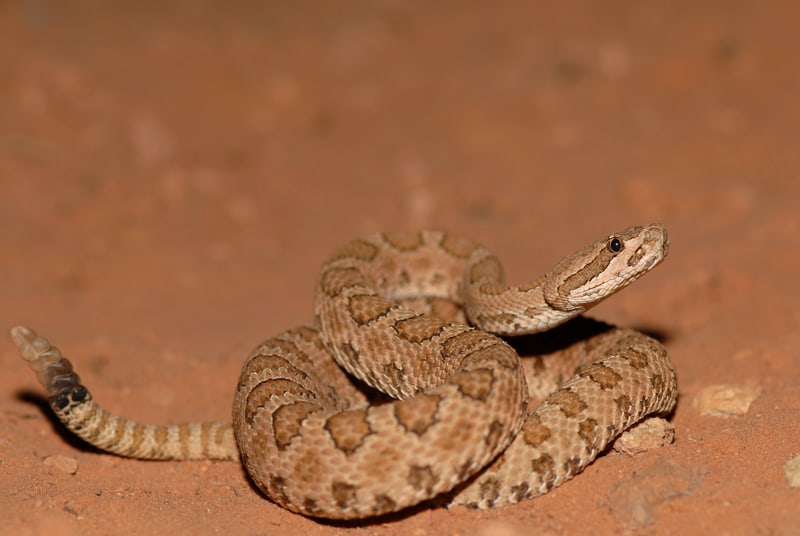
Midget-faded Rattlesnake (Crotalus concolor)
Midget Faded rattlesnakes are cream, brownish-grey, or a straw-like color. This species is a subspecies of the western rattlesnake. Adults grow from 20 to 30 inches (508 to 762mm) long. Males are usually longer and heavier than females.
Other names for this snake are the Faded Rattlesnake and Yellow Rattlesnake.
Where Do Midget-faded Rattlesnakes Live in Colorado?
In Colorado, Midget faded rattlers live in the west-central part of the state. This is in the Green River formation. This area comprises Moffat, Rio Blanco, Mesa, Garfield, Delta, and Montrose Counties.
How Dangerous Are Midget-faded Rattlesnakes?
Midget Faded rattlesnake venom has strong neurotoxic properties. Their venom is more toxic than that of some cobras. A bite from this snake interferes with the transmission of nerve impulses. Symptoms of neurotoxic envenomation include droopy eyelids, frothy saliva, and slurred speech. More serious effects include paralysis of the skeletal muscles and respiratory failure. Source Source
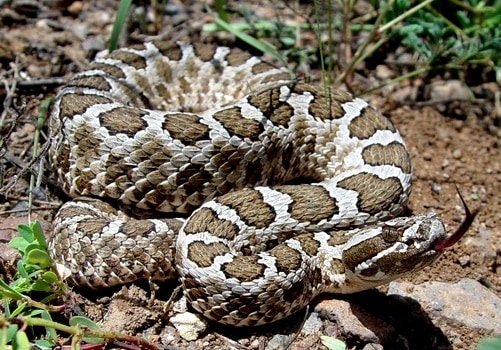
Desert Massasauga Rattlesnake (Sistrurus t. edwardsii)
What Do Desert Massasauga Rattlesnakes Look Like?
| Size | *Adults reach a body length of 21 inches (53cm). |
| Coloration | *Their base color is pale gray. *Younger snakes are paler than adults. |
| Dorsal Spots | *A row of large, rounded, dark brown spots run down their spine. *They have three smaller rows of spots down each side. *In some cases, the larger dorsal spots connect with the side spots, forming a large solid blotch. |
| Face | They have a dark stripe on each side of their face and across their eye. |
Massasaugas have a high-pitched rattle sound, which is different from other rattlesnakes. This is why they have the nickname Buzztail.
Where Do Desert Massasauga Rattlesnakes Live in Colorado?
These snakes are found in the arid grasslands of southeastern Colorado. See
How Dangerous Are Desert Massasauga Rattlesnakes?
The venom of the Massasauga rattlesnake is cytotoxic. Cytotoxic venom destroys body tissue. Moreover, digestive enzymes in cytotoxic venom disrupt blood flow and prevent clotting. Massasauga bites to humans are rare. However, they do occur.
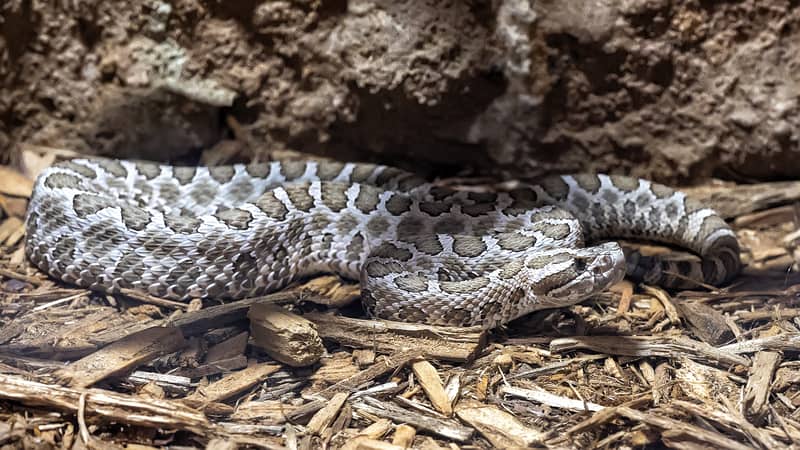
Western Massasauga Rattlesnakes (Sistrurus tergeminus)
What Do Western Massasauga Rattlesnakes Look Like?
| Size | *Adults range from 14 to 36 inches (36 cm to 91cm) long. |
| Coloration | *Their base color is light gray. *Younger snakes are paler than adults. |
| Dorsal Spots | *A row of large, rounded, dark brown spots run down their spine. *They have three smaller rows of spots down each side. *In some cases, the larger dorsal spots connect with the side spots, forming a large solid blotch. |
| Face | They have a dark stripe on each side of their face and across their eye. |
Massasaugas have a high-pitched rattle sound, which is different from other rattlesnakes. This is why they have the nickname Buzztail.
Where Do Western Massasauga Rattlesnakes Live in Colorado?
These snakes are found in the sandy terrain of southeastern Colorado.
Western Massasauga’s live in Lincoln, Cheyenne, El Paso, Pueblo, Crowley, Kiowa, Otero, Las Animas, Prowers, Baca, and Bent Counties.
How Dangerous Are Western Massasauga Rattlesnakes?
The venom of the Massasauga rattlesnake is cytotoxic. Cytotoxic venom destroys body tissue. Moreover, digestive enzymes in cytotoxic venom disrupt blood flow and prevent clotting. Massasauga bites to humans are rare. However, they do occur.
There are two documented deaths in Ontario from Eastern Massasauga envenomations. In each case, the victim did not receive antivenom in time.
Colorado Snakes That Imitate Venomous Snakes
Batesian mimicry is a biological term. It describes how a harmless species protects itself by resembling a dangerous one.
There are a handful of nonvenomous snakes in Colorado that imitate coral snakes. A couple of them are the king snake and the milk snake.
Also, the Great Basin gopher snake resembles a rattlesnake in coloration. Moreover, they flatten their heads and vibrate their tails when threatened. This helps them to resemble a rattlesnake more closely. However, these snakes are non-venomous.
Northeastern and southeastern Colorado is home to the northern water snake (Nerodia sipedon). Northern water snakes are sometimes mistaken for venomous cottonmouths. However, they are not venomous. Although northern water snakes are not venomous, their saliva does contain an anticoagulant. This could make the bite area from one of these snakes difficult to heal.

Western Hognose Snake (Heterodon nasicus)
Colorado is also home to the Western Hognose snake. The western hognose snake is a rear-fanged colubrid snake and is mildly venomous. However, they are not dangerous to humans.
The western hognose snake, also known as the blow snake, the bluffer, or the faux viper. They are relatively short and stout-bodied. Their color pattern is variable. But most subspecies of this snake resemble a rattlesnake in coloration.
These snakes derive their common name from an upturned nose scale. It gives their snout a long, hoglike appearance.
Western Hognose snakes in Colorado live from the front range eastward. There is also an isolated population of these snakes in Moffat County. This is in the northwestern corner of the state.
Here is a case of a western Hognose snakebite.
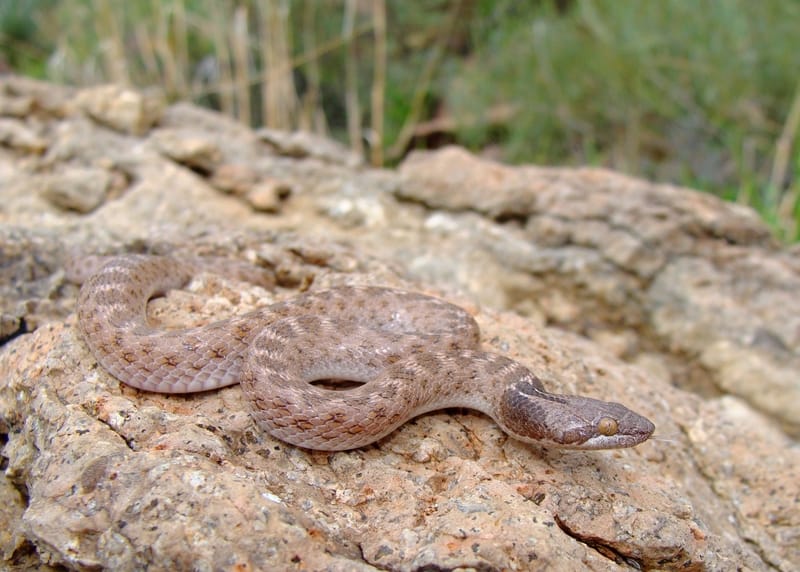
Texas Night Snake (Hypsiglena jani)
There are 17 Night snake sub-species. Colorado’s version is the Texas Night Snake, also called the Chihuahun Night Snake.
Night Snakes are rear-fanged, slightly venomous snakes. Texas Night Snakes grow from 10 to 16 inches (25 to 41cm) long. This snake is a light beige to pale gray with dark gray or brown blotches on its sides and back. Its head is flat and triangular-shaped, with a dark brown bar behind its eyes. It also has a pair of dark blotches on the neck. Its belly is a whitish color.
Although Night snakes are slightly venomous, they are not a threat to humans.
Texas Night Snakes are found in southern Colorado.
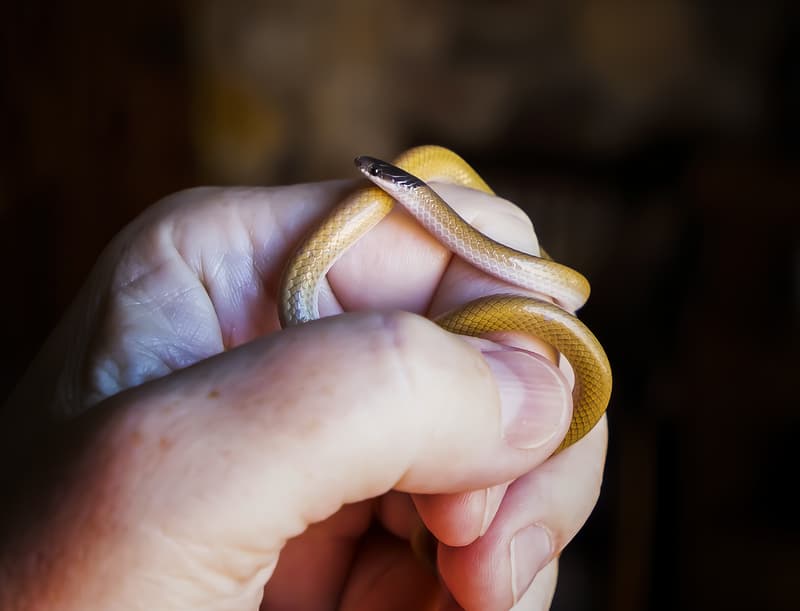
Southwestern Blackhead Snake (Tantilla hobartsmithi)
The Southwestern Blackhead is a tiny snake. Adults are 8 to 15 inches (20 to 38cm) long. The top of their body is brown in color with a blackhead. The belly is creamy white with a broad reddish stripe running down the center.
Southwestern Blackhead snakes are nocturnal. They spend most of their time hiding in loose soil or underground debris. These are rear-fanged snakes whose venom is harmless to humans.
Southwestern Blackhead snakes live in western Colorado. In canyon bottom habitats.
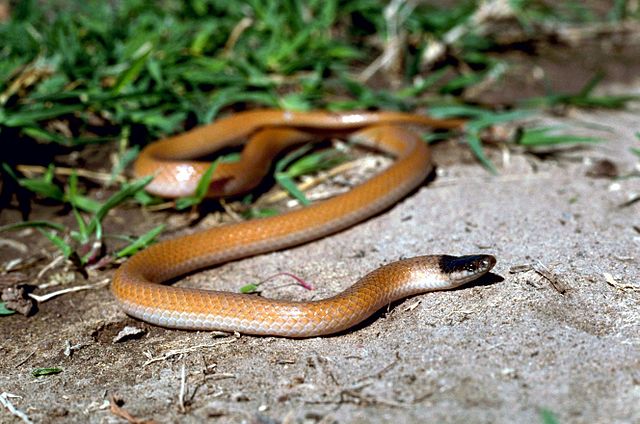
Plains Blackhead Snake (Tantilla nigriceps)
Like the Southwestern Blackhead, the Plains Blackhead is a tiny snake. Adults are 7.1 to 15 inches (18 to 38cm) long. These snakes’ heads are black, while their bodies are grayish-brown. Their bellies are white with a pink or orange stripe down the center.
Plains Blackhead snakes are nocturnal. They spend most of their time hiding in loose soil or underground debris. These are rear-fanged snakes whose venom is harmless to humans.
The Plains Blackhead snake lives in eastern Colorado.
Garter Snakes
Colorado is also home to 5 species of garter snakes. Until recently, garter snakes were believed to be non-venomous. However, in the early 2000s, scientists made an interesting discovery. They found that garter snake saliva contains a mild neurotoxic venom. Luckily, garter snakes are incapable of seriously injuring humans. Their teeth are too small to break the skin in most instances. Garter snake envenomation primarily causes skin irritation in humans.
The garter snake species that live in Colorado are the following.
- Common Garter snake (Thamnophis sirtalis)
- Black-necked Garter snake (Thamnophis cyrtopsis)
- Western Ribbon Snake (Thamnophis proximus)
- Plains Garter Snake (Thamnophis radix)
- Western Terrestrial Garter Snake (Thamnophis elegans)

Common Garter Snake (Thamnophis sirtalis)
The Common Garter snake, or Red-sided Garter snake, is found across most of North America. Interestingly, these snakes come in various colors. These include green, blue, yellow, gold, red, orange, brown, and black. What’s more, they grow up to about 4 feet (122cm) long. However, most stay smaller than that. Most of them have vertical stripes that are yellow to brown over a darker background. These snakes sometimes secrete a foul-smelling fluid from postanal glands when handled.
Common Garter snakes are found in Northern Colorado.
.

Black-necked Garter Snake (Thamnophis cyrtopsis)
Black-necked garter snakes are native to the southwestern United States, Mexico, and Guatemala. Their range in Colorado is limited to the southern part of the state.
These snakes are olive-colored with contrasting lateral stripes. They have a stripe down the center of their back that is typically orange or yellow. The closer it extends towards their head, the more vivid this stripe becomes. They also have a whiteish or cream-colored stripe on each side. Additionally, they have black neck patches on either side of the dorsal stripe. Their heads are bluish-gray on top, transitioning to cream-colored upper and lower jaws. The largest black-necked garter snakes are up to 42 inches (107cm) long.

Western Ribbon Snake (Thamnophis proximus)
The Western Ribbon snake is a sub-species of the garter snake. It is endemic to the western United States, Mexico, and Central America. In Colorado, the western ribbon snake lives in a very small area in the southeastern portion of the state.
Adult Western Ribbon snakes measure 17–50 inches (43–127 cm) long. They are olive-brown with three yellowish stripes. These stripes are located on the spine and each side of the snake. Their bellies are greenish or yellowish-white. The top of their head is dark green with a white spot in the center.

Plains Garter Snake (Thamnophis radix)
The Plains Garter snake is native to the central United States, from Texas north to Canada. They are mainly greyish green in color with a yellow stripe that stretches from their head to their tail. Plains Garter snakes live from Colorado’s Front Range east through the rest of the state.

Western Terrestrial Garter Snake (Thamnophis elegans)
The Western terrestrial garter snake inhabits western North America. It is a very phenotypically variable species. Most of them have a white, yellow, or light orange stripe along their top. They also have two stripes of the same color, one on each side. Often, they have red or black spots between their dorsal stripe and their side stripes. Their variability makes it challenging for even experienced herpetologists to identify these snakes.
There are both coastal and inland varieties of this species. Obviously, the ones in Colorado are of the inland variety. They eat a semi-aquatic diet. This includes amphibians, leeches, and fish. Their terrestrial prey are rodents, small reptiles, and insects.
Western terrestrial garter snakes live throughout Colorado except in the northeastern corner.
Avoiding Snake Bite
Eastern Copperheads are the species responsible for the most venomous snake bites in Illinois. These snakes rely on their excellent camouflage to stay hidden. They often remain perfectly still to avoid detection. If you’re walking in the woods and unknowingly get too close, a copperhead might not move, hoping you’ll pass by. Many bites happen when someone accidentally steps on the snake. To stay safe in snake habitats, always watch where you step and where you place your hands.
Another common cause of snake bite is attempts to capture or kill a snake. Remember, venomous snakes can strike instantly, delivering a potentially life-threatening bite. The safest approach is to keep a safe distance and leave them alone.
Dressing for Snake Country
- High-top leather boots and long pants are both wise ideas.
- Also, wear loose-fitting denim. If there’s a gap before the snake’s fangs touch your skin, your chances of being envenomated are lower.
- In the absence of high-top leather boots, some people wear snake gaiters.
Symptoms of Venomous Snake Bites
Some of the symptoms you may experience from a venomous snake bite include:
- Discoloration in the area of the bite.
- Swelling in the area of the bite.
- Loss of muscle coordination.
- Tingling sensation in the area of the bite.
- Feeling nauseous.
- Having an abnormally rapid pulse.
What Should You Do If A Venomous Snake Bites You?
If you or someone you are with has suffered a venomous snakebite, time is of the essence. This is because the sooner a victim receives anti-venom, the less likely the venom in their body is to cause harm. In other words, it is important to seek immediate medical attention.
Do not attempt to kill the snake for identification purposes. This gives the snake a chance to bite you again. Also, consider that severed snakeheads can still bite and envenomate. If you have a phone, take a picture of the offending reptile. Otherwise, get started on your way to the doctor.
First Aid for Snake Bite Victims
- Remain calm and limit your movements. Do not run. If you must hike back to a vehicle, do it calmly and deliberately. Put as little stress on your heart as possible.
- Keep the area of the snake bite below the heart level and never above the heart level. Keeping the bite below the heart level will reduce the venom’s flow. However, holding the bite above your heart level will increase the venom’s flow.
- Remove all constricting items such as bracelets, watches, or rings before swelling occurs.
- Remember that using a cold compress on a venomous snake bite is not advisable. The cold may cause the local blood vessels to constrict and spread the venom faster.
- You can wash the affected area like any other wound with soap and water.
- You may cover the bite area with a moist dressing to reduce the swelling.
- Get medical attention as soon as possible. Call the hospital to tell them a venomous snake has bitten you. So they can have anti-venom ready to give you when you arrive.
- A person whom a venomous snake has bitten may go into shock. If this happens, lay them flat and cover them with a blanket.
Recent Posts
The only venomous snakes in Washington State are Northern Pacific Rattlesnakes. The Northern Pacific Rattlesnake (Crotalus oreganus oreganus) is a sub-species of the Western Rattlesnake. Anyone...
Skunks are not classified as true hibernators. But they go into a state of torpor when the weather gets cold. Skunks are light sleep hibernators, along with opossums, bears, and raccoons. ...
